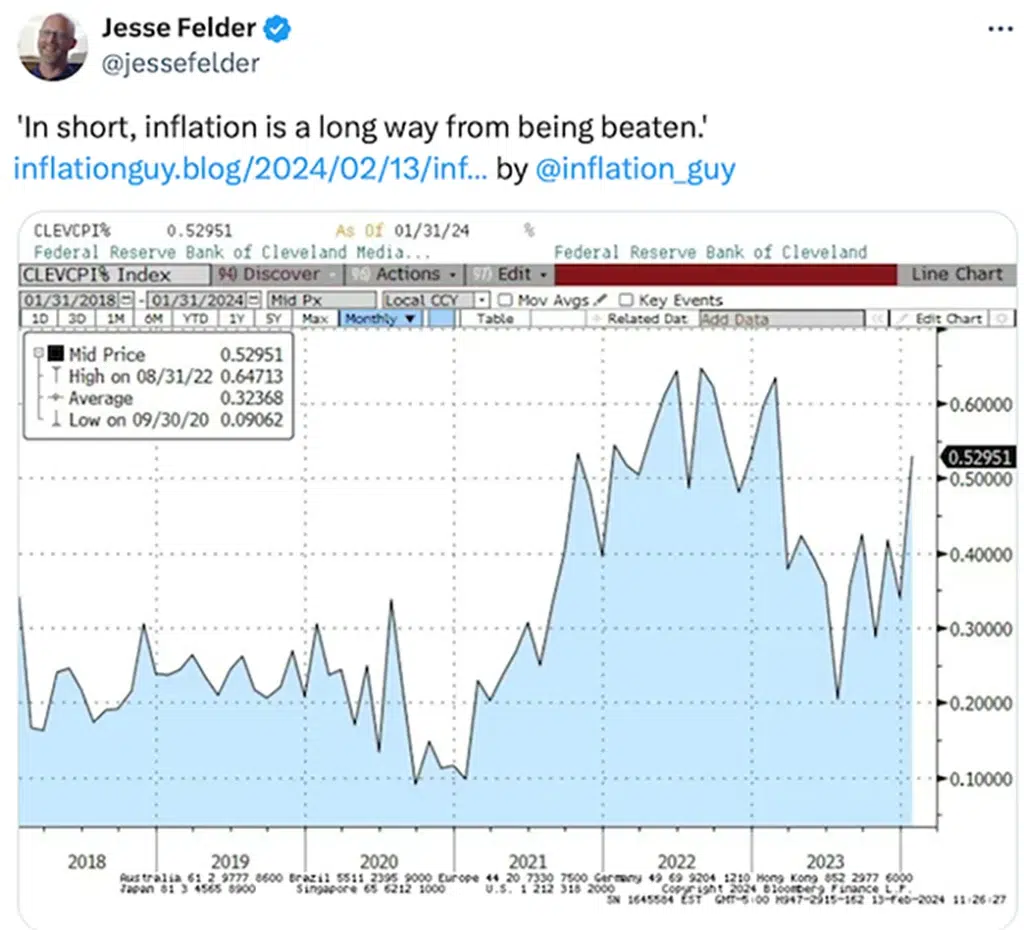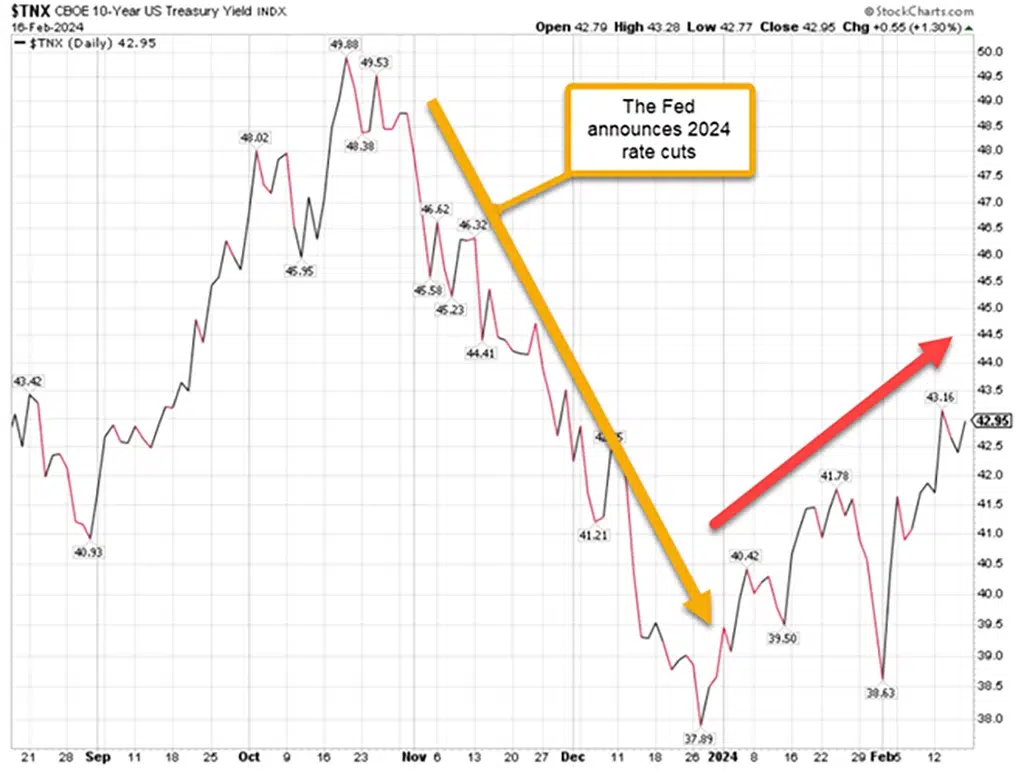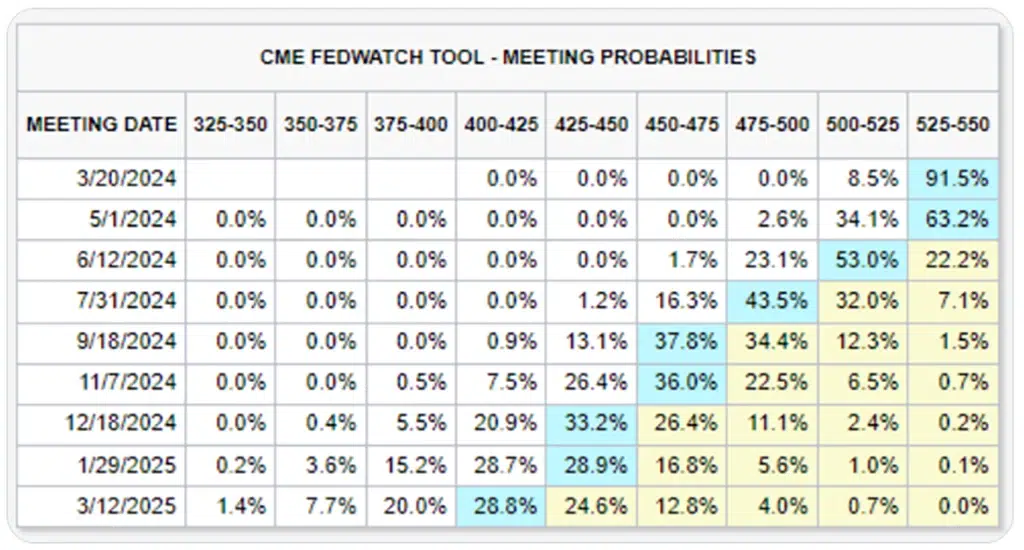Weekly Market Outlook
By Donn Goodman
February 21, 2023
Welcome Market Outlook readers. Last week’s market action was a lot like the action at the Super Bowl the Sunday prior. It was a nail biter at the end. Whether it is a football game or investing, it is always about the “little things” that make the difference. Critical game plans and strategies always factor in. It reminds me of successful investing and trading. For us, it replicates how and why our quant models work. It’s always the small things that make the biggest difference like taking off profits and/or utilizing stops.
Higher for longer.
If you are a frequent reader of this weekly Market Outlook along with Mish’s Daily, you know that we have both been suggesting that inflation would likely tick up after the past few month’s plunge lower. This would likely mean interest rates could possibly go back up (they fell much too fast). We have both often stated that what investors expect will happen in a given time, rarely works out that way.
This was the case this past week. Tuesday morning (Feb 13) the CPI was released and was “hotter” than expected. As we saw in the 1970s, driving inflation down is tricky. Seldom, if ever, do economic actions result in smooth lines. We both said this towards the end of the year. My message was clear in December: volatility and higher risk would likely be more prevalent in 2024. This past week was an accurate demonstration of just that.
Peak inflation is likely behind us.
Last week the CPI (Consumer Price Index) and the PPI (Producer Price Index) inflation reports confirmed that inflation continues to decline. However, expectations were for a much bigger drop in the CPI year-over-year number from 3.4% to 2.9%. Instead, the CPI surprised to the upside with a 3.1% year-over-year print on the headline number. The monthly number was 0.3% versus the expected 0.2%. Rent prices have stayed stubbornly high and had a material impact on the monthly number.
Other analysts were quick to point out that January is a seasonal period and prone to a higher monthly number. That may or may not be true, but it offers a good explanation especially for TV market shows.
Given oil prices rising (and gasoline at the pump), grocery/food prices staying high, and other areas of the economy not slowing as expected, persistent inflation may be hard to knock down.
However, core CPI (ex-food and energy) is currently at 3.9% y/y and down significantly from last summer’s high of 6.6%. See chart below:

Core PPI (wholesale inflation) is at 2.0 y/y, also down from last year’s summer peak of 8.2%. So, the needle is moving more toward the green.
The latest Personal Consumption Expenditure (PCE) index (the Fed’s preferred inflation gauge) showed inflation at 3.2% y/y, down from last year’s peak of 5.3%
While it may be true that these inflation indicators ticked up due to a seasonal bias, the fact remains that we are a long way from the Fed’s targeted 2.0% inflation rate. Inflation, as we have pointed out on many occasions, will be hard to bring down to the Fed’s target rate. See the illustration below:

Most of you are aware that the higher CPI number threw a monkey wrench into the markets on Tuesday, as we had the single biggest one-day decline since last March 2023. More importantly, interest rates continued rising this past week.
Rising interest rates typically have an impact on risk assets (as they did Tuesday) but thanks to the better-than-expected earnings reports that have been delivered these past few weeks during earnings season, the market’s resiliency has held up. Following the big decline on Tuesday, the markets moved higher on Wednesday and Thursday until Friday’s PPI report led to a down day to end the week.
See the illustration below of the recent move higher in the 10-year interest rates.

While it’s true that the recent CPI and PPI reports showed inflation falling a little bit less than expected, it’s not likely to alter the Fed’s thinking on rate cuts.
Those sentiments were echoed earlier this week by Austan Goolsbee, the President and CEO of the Federal Reserve Bank of Chicago, when he said what many in the market were already thinking, which is,
"Let's not get amped up on one month of CPI that was higher than it was expected to be." He continued by saying, "if you see inflation up a little bit, that doesn't mean that we're not on the target to get to 2%. We can still be on the path even if we have some increase and some ups and downs --- so let's not get too flipped out."
Austan Goolsbee, the President and CEO of the Federal Reserve Bank of Chicago Tweet
Last November, investors interpreted the Fed’s more dovish posture and immediately factored in as many as 6 rate cuts. We did not buy it. (we still don’t unless there is a major economic collapse). GDP growth is projected to stay positive during 2024. This would be consistent with the economic patterns that are typical in the 4th year of a Presidential cycle and especially during an election year. This would also mean that the US might possibly avert the dreaded Recession that many bond managers have been calling for (see Gundlach and Gross).
Additionally, earnings are growing at a higher rate than all the analysts’ and street’s expectations. This should be a positive contribution to bullish sentiment for stocks in 2024.
The interest rate projection for Fed rate cuts was recently altered after the January and February CPI/PPI releases. Most investors are now factoring in no more than 4 rate cuts and not beginning until June.
We would suggest that the Fed is between a rock and a hard place. If they are going to reduce the overnight Fed Funds rate, they probably should do it before June/July. The summer begins the Election cycle which includes the Political (DNC and RNC) conventions. I believe the Fed will try to refrain from the perception that it is meddling with the upcoming election.
See the below commentary and graph that follows the % probabilities of the Fed lowering rates:
It’s official, higher for longer is back: For the first time this year, markets are now pricing-in just 4 interest rate cuts in 2024. Just 6 weeks ago, markets were expecting 6 interest rate cuts in 2024. More importantly, the timing of the first rate cut has been pushed all the way back to June 2024. There is now only a 9% chance of rate cuts beginning in March 2024, down from 90% just 6 weeks ago. There is also a ~63% chance that interest rates are unchanged through May 2024. Rate cuts are all but guaranteed.

The Stock Market
Use the links below to continue reading about:
- Use the links below to continue reading about:
- Insight into the many ways in which the stock market digested last week’s news
- Record breaking market concentration metrics
- The bullish Valentine Indicator
- The broadening out of the bull market
- Sector rotation
- The Big View bullets
- Keith’s weekly video analysis
- And more!













